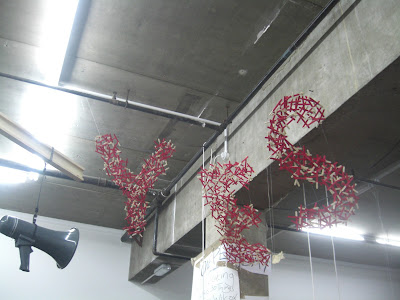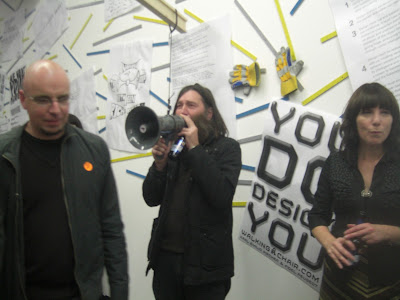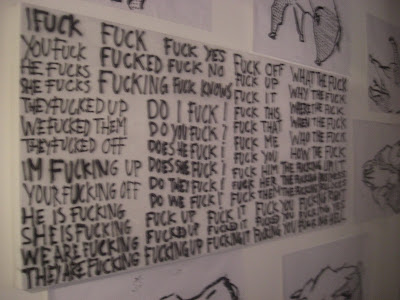Sunday, 7 November 2010
Food Hub Logo design
Triangular thinking.
Sent to you by Jessica via Google Reader:
Triangular Design Manifesto, by Conceptual Devices:
00_ Design should not be based on formal principles – but always on an idea of society.
01_ Designed forms represent possible social orders and a lot of their contradictions.
02_ Design is everything. Anything could be designed. Everyone is a designer.
03_ Design allows social innovations. Often it is not made by designers.
04_ Design has not scale. It could be small and have great impact.
05_ Design is not an innocent practice. Designers are wicked.
06_ Design should engage people and interact with them.
07_ Design is an interdisciplinary applied science.
08_ Design produces visual consciousness.
09_ Design is a triangular manifesto.
10_ Design makes you smile.
11_ This is the top.
12_ Enjoy!
Things you can do from here:
- Subscribe to swissmiss using Google Reader
- Get started using Google Reader to easily keep up with all your favorite sites
Sunday, 3 October 2010
Points of Transition – Anti-design Festival
Saturday, 2 October 2010
Opening night – Anti-design festival
Wednesday, 8 September 2010
Fresh(ers) Workshop
Wednesday, 25 August 2010
xyxx
Sent to you by Jessica via Google Reader:

A love letter is one of the oldest (and still most special) ways to make someone's heart flutter. But, what happens when words are no longer surprising or initmate enough? xyxx happens. In the originators own words, "xyxx is a living visual, open ended love letter between two slightly twisted lovers who would rather take pictures with their iphones than talk on them." They never, ever manipulate them on the computer, relying solely on the apps on their next-gen walkie-talkies to tweak and deliver.
Things you can do from here:
- Subscribe to It's Nice That using Google Reader
- Get started using Google Reader to easily keep up with all your favourite sites
Sunday, 22 August 2010
Cutlasercut cutting
I should have done this ages ago.
—A poster concept for the London based laser cutting company Cutlasercut.
sebastian errazuriz: american kills
Sent to you by Jessica via Google Reader:

'american kills' installation
'american kills' by chilean-born new york based artist sebastian errazuriz is a public
installation showcasing the suicide rates of US soldiers. after searching on official
war sites on the internet, he accidentally found out that 2 times more american soldiers
had died in 2009 by committing suicide than those killed during that same year in the
war in iraq; an alarming comparison that errazuriz had personally never read or
heard about before.

according to the artist, a first google search showed only reports of media alarm about
suicide rates, but the information was always comfortably presented divided into months
and generally separated by statistics from the army, navy or air-force.

'when I first found the overall statistics summed the 304 suicides by US soldiers during
2009, I was shocked. I tried to find a number to compare that statistic. to my surprise
the suicide statistic doubled the total of 149 US soldiers that had died in the iraq war
during 2009 and equaled the number of soldiers killed in afghanistan.' - SR

errazuriz's first instinct was to post the statistic on facebook, dumbfounded by the lack
of response and interest, he bought can of black paint and decided to 'post' the news in
the real world on his own wall outside his studio in brooklyn. equipped with a ladder,
he marked a black strip for every dead soldier, until both the suicide rates and war rates
occupied the entire wall and were registered as a single image.

'the counting of dead soldiers outside my studio was long and surprisingly eerie; it was
hard to forget that every brush stroke was a soldier who had died the previous year.
a lot of people stopped to read the mural and were immediately impressed by the reality
portrayed. most of them seemed quite shocked and approached me to ask if what I was
painting was real. I tried to explain that I simply wished to create a physical image that
could capture people's imagination, creating awareness of the current numbers in death,
war and the infinite discrepancy between the resources and energies destined to fight and
protect soldiers at war versus the energies invested in protecting their mental health
and stability.'- SR
Things you can do from here:
- Subscribe to Designboom - Weblog using Google Reader
- Get started using Google Reader to easily keep up with all your favourite sites
Wednesday, 23 June 2010
World Cup Lecture
Monday, 21 June 2010
Friday = D-day
Sunday, 13 June 2010
Letterpress prep-work
Tuesday, 1 June 2010
Super Graphics 2010 Publication
Thankfully the Heidelberg press we're printing on is up and running again so the job can progress – slowly, with long hours from Toni in the print department – and fingers crossed may actually be completed on time (possibly even in budget).
Now for the cover…
Friday, 7 May 2010
Thursday, 6 May 2010
Screen-printed envelops
Wednesday, 5 May 2010
Flocking fun
Tuesday, 4 May 2010
Monday, 3 May 2010
Burlesqued CMYK

'…the poet who surpasses the painter in praising onions, can add a zero to my nine.'
(Bronzino. La cipolla)
Developing my transformation of Bronzino's Venus, Cupid, Folly & Time I researched the painter's other creative love – Burlesque poetry. Known for its obscurity – a highly coded lexicon and reference to cultural ideas and practices inaccessible to readers today – Burlesque poetry applied erotic significance to numbers due to the resemblence of their shapes. In the quote above, Bronzino is not suggesting that such poet is 10 times greater than said painter but utilising the roundness of the 0 and the phallic 9 to convey a much more controversial statement.
I applied this reference to my original CMYK translation with the intention of transforming more than just the aesthetics of the piece – it seemed ignorant to leave behind the complex undertones of the artwork.
Sunday, 2 May 2010
Visual rhythm


In developing the past,present, future project, Marjo and I explored the idea of subverting the sensory measurement of a space to interpret the illusion of time.








































